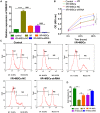Silencing of SNHG12 Enhanced the Effectiveness of MSCs in Alleviating Ischemia/Reperfusion Injuries via the PI3K/AKT/mTOR Signaling Pathway
- PMID: 31293373
- PMCID: PMC6603177
- DOI: 10.3389/fnins.2019.00645
Silencing of SNHG12 Enhanced the Effectiveness of MSCs in Alleviating Ischemia/Reperfusion Injuries via the PI3K/AKT/mTOR Signaling Pathway
Abstract
Previous studies have reported that the long non-coding RNA SNHG12 (lncRNA SNHG12) plays a critical role in regulating the function of mesenchymal stem cells (MSCs); however, the effect of lncRNA SNHG12 on MSCs in injured brain tissue has rarely been reported. We studied the effect and mechanism of lncRNA SNHG12-modified mesenchymal stem cells (MSCs) in treating brain injuries caused by ischemia/reperfusion (I/R). I/R treated rat brain microvascular endothelial cells (BMECs) were co-cultured with MSCs or I/R pretreated MSCs. Next, BMEC proliferation was detected by using CCK-8 and EdU assays, and cell apoptosis was determined by using flow cytometry and the Hoechst staining method. Autophagy of BMECs was determined using immunofluorescence and expression of associated pathway proteins were measured by western blotting. Moreover, BMEC proliferation, apoptosis, and autophagy were also determined after the BMECs had been co-cultured with shSNHG12-MSCs. In addition, a rat model of middle cerebral artery occlusion (MCAO) was used to further confirm the findings obtained with cells. I/R treatment significantly decreased the proliferation of BMECs, but increased their levels of SNHG12 expression, apoptosis, and autophagy. However, co-culturing of BMECs with MSCs markedly alleviated the reduction in BMEC proliferation and the increases in BMEC apoptosis and autophagy, as well as the phosphorylation of PI3K, AKT, and mTOR proteins in BMECs that had been induced by I/R. Furthermore, shSNHG12 remarkably enhanced the effects of MSCs. In addition, an injection MSCs reduced the infarct areas and rates of cell apoptosis in MACO rats, and reduced the phosphorylation of PI3K, AKT, and mTOR proteins. Moreover, shSNHG12 enhanced the ameliorative effect of MSCs in treating brain injuries in the MACO rats. In conclusion, silencing of SNHG12 enhanced the effects of MSCs in reducing apoptosis and autophagy of BMECs by activating the PI3K/AKT/mTOR signaling pathway.
Keywords: SNHG12; apoptosis; autophagy; ischemia/reperfusion injury; mesenchymal stem cell.
Figures






Similar articles
-
Tong-Qiao-Huo-Xue decoction activates PI3K/Akt/mTOR pathway to reduce BMECs autophagy after cerebral ischemia/reperfusion injury.J Ethnopharmacol. 2022 Nov 15;298:115585. doi: 10.1016/j.jep.2022.115585. Epub 2022 Jul 31. J Ethnopharmacol. 2022. PMID: 35921993
-
LncRNA SNHG12 as a potent autophagy inducer exerts neuroprotective effects against cerebral ischemia/reperfusion injury.Biochem Biophys Res Commun. 2019 Jun 25;514(2):490-496. doi: 10.1016/j.bbrc.2019.04.158. Epub 2019 May 2. Biochem Biophys Res Commun. 2019. PMID: 31056262
-
Hydroxysafflor yellow a protects brain microvascular endothelial cells against oxygen glucose deprivation/reoxygenation injury: Involvement of inhibiting autophagy via class I PI3K/Akt/mTOR signaling pathway.Brain Res Bull. 2018 Jun;140:243-257. doi: 10.1016/j.brainresbull.2018.05.011. Epub 2018 May 15. Brain Res Bull. 2018. PMID: 29775658
-
The Long Non-coding RNA SNHG12 Functions as a Competing Endogenous RNA to Modulate the Progression of Cerebral Ischemia/Reperfusion Injury.Mol Neurobiol. 2022 Feb;59(2):1073-1087. doi: 10.1007/s12035-021-02648-8. Epub 2021 Nov 27. Mol Neurobiol. 2022. PMID: 34839459
-
LncRNA SNHG12 inhibits miR-199a to upregulate SIRT1 to attenuate cerebral ischemia/reperfusion injury through activating AMPK signaling pathway.Neurosci Lett. 2019 Jan 18;690:188-195. doi: 10.1016/j.neulet.2018.08.026. Epub 2018 Aug 22. Neurosci Lett. 2019. PMID: 30144542
Cited by
-
Oxidative Stress, Inflammation, and Autophagy: Potential Targets of Mesenchymal Stem Cells-Based Therapies in Ischemic Stroke.Front Neurosci. 2021 Feb 26;15:641157. doi: 10.3389/fnins.2021.641157. eCollection 2021. Front Neurosci. 2021. PMID: 33716657 Free PMC article. Review.
-
TIMP3 attenuates cerebral ischemia/reperfusion-induced apoptosis and oxidative stress in neurocytes by regulating the AKT pathway.Exp Ther Med. 2021 Sep;22(3):973. doi: 10.3892/etm.2021.10405. Epub 2021 Jul 8. Exp Ther Med. 2021. PMID: 34335915 Free PMC article.
-
CUEDC2 ablation enhances the efficacy of mesenchymal stem cells in ameliorating cerebral ischemia/reperfusion insult.Aging (Albany NY). 2021 Jan 20;13(3):4335-4356. doi: 10.18632/aging.202394. Epub 2021 Jan 20. Aging (Albany NY). 2021. PMID: 33494071 Free PMC article.
-
Expression of Long Non-coding RNA RGD1566344 in the Brain Cortex of Male Mice After Focal Cerebral Ischemia-Reperfusion and the Neuroprotective Effect of a Non-coding RNA RGD1566344 Inhibitor.Cell Mol Neurobiol. 2021 May;41(4):705-716. doi: 10.1007/s10571-020-00877-4. Epub 2020 May 18. Cell Mol Neurobiol. 2021. PMID: 32424772 Free PMC article.
-
A Network Pharmacology Approach for Exploring the Mechanisms of Panax notoginseng Saponins in Ischaemic Stroke.Evid Based Complement Alternat Med. 2021 Aug 13;2021:5582782. doi: 10.1155/2021/5582782. eCollection 2021. Evid Based Complement Alternat Med. 2021. PMID: 34434246 Free PMC article.
References
LinkOut - more resources
Full Text Sources
Miscellaneous

